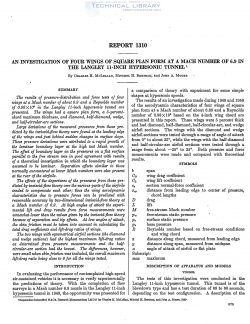naca-report-1310
- Version
- 179 Downloads
- 1.15 MB File Size
- 1 File Count
- November 2, 2016 Create Date
- November 2, 2016 Last Updated
National Advisory Committee for Aeronautics, Report - An Investigation of Four Wings of Square Plan Form at a Mach Number of 6.9 in the Langley 11'' Hypersonic Tunnel

The results of pressure-distribution and force tests of four
wings at a Mach number of about 6.9 and a Reynolds number
of 0.98X10‘7 in the Langley 11-inch hypersonic tunnel are
presented. The wings had a square plan form, a 5—percent-
chord maximum thickness, and diamond, half-diamond, wedge,
and half-circzdar-arc sections.
Large deviations of the measured pressures from those pre—
dicted by the inviscid-flow theory were found at the leading edge
of the wings and just behind sudden changes in surface slope.
These pressure deviations were attributed to a rapid growth of
the laminar boundary layer at the high test Mach number.
The eject of boundary layer on the pressures on a flat surface
parallel to the free stream was in good agreement with results-
of a theoretical investigation in which the boundary layer was
assumed to be laminar. Separation eflects similar to those
normally encountered at lower Mach numbers were also present
at the rear of the airfoils.
The ejects of the departures of the pressures from those pre-
dicted by inviscid-flow theory over the various parts of the airfoils
tended to compensate each other; thus the wing aerodynamic
characteristics due to pressure forces can be predicted with
reasonable accuracy by two-dimensional inviscid—flow theory at
a Mach number of 6.9. At high angles of attach: the experi—
mental lift and drag results from force measurements were
somewhat lower than the values given by the inviscid-flow theory
because of separation and tip efi‘ects. At low angles of attack,
the skin friction must be taken into account in calculating the
total drag coefficients and lift-drag ratios of wings.
The two wings with symmetrical airfoil sections (the diamond
and wedge sections) had the highest maximum lift-drag ratios
as determined from pressure measurements and the half-
circularnrc section had the lowest. The diferences, however,
were small when skin friction was included, the overall maa-imum
lift—drag ratio being close to 6 for all the wings tested.
In evaluating the performance of contemplated high-speed
air-sustained vehicles it is necessary to verify experimentally
the predictions of theory. With the completion of flow
surveys in a Mach number 6.9 nozzle in the Langley 11-inch
hypersonic tunnel in 1949, the opportunity was presented for
a comparison of theory with experiment for some simple
shapes at hypersonic speeds.
| File | Action |
|---|---|
| naca-report-1310 An Investigation of Four Wings of Square Plan Form at a Mach Number of 6.9 in the Langley 11'' Hypersonic Tunnel.pdf | Download |

Comment On This Post